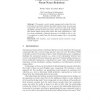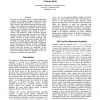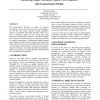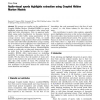104 search results - page 11 / 21 » Discovering Hidden Knowledge from Biomedical Literature |
AIMSA
2006
Springer
13 years 11 months ago
2006
Springer
Abstract. We present a novel, simple, unsupervised method for characterizing the semantic relations that hold between nouns in noun-noun compounds. The main idea is to discover pre...
NDQA
2003
13 years 9 months ago
2003
With the ever-increasing amount of textual information available, it is becoming increasingly unlikely that a single document will provide the answer to a question. A more likely ...
BMCBI
2005
13 years 7 months ago
2005
Background: Massive text mining of the biological literature holds great promise of relating disparate information and discovering new knowledge. However, disambiguation of gene s...
ICML
1991
IEEE
13 years 11 months ago
1991
IEEE
The psychological literature on stages of cognitive development was reviewed and found to contain support for the idea that stages represent ordinal, qualitative changes in organi...
PAA
2006
13 years 7 months ago
2006
We present our studies on the application of Coupled Hidden Markov Models(CHMMs) to sports highlights extraction from broadcast video using both audio and video information. First,...




